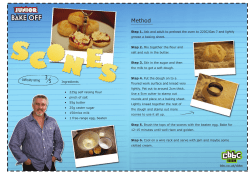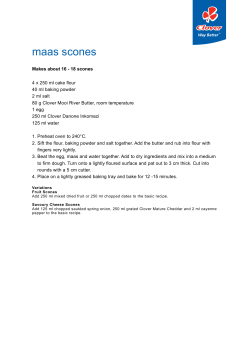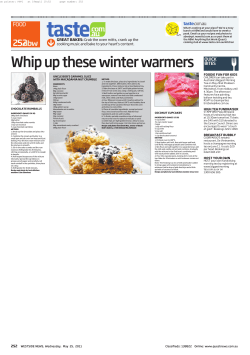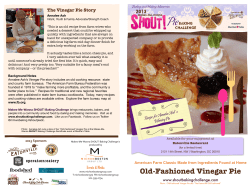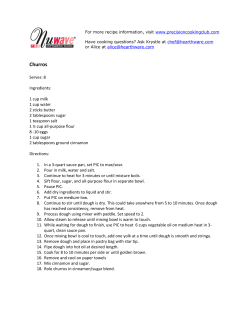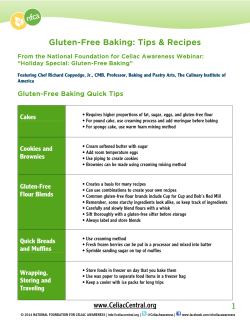
General Cooking Instructions & Information
General Cooking Instructions & Information Introduction The purpose of this document is to give you an outline of methods and ingredients so that you can prepare meals for First Virginia events. It includes recipes and instructions for preparation, storage, delivery and serving at the event. Prepare Ahead of Time You can make a wide variety of authentic meals ahead of time and bring them to an event. While th this does not allow the public to see the preparation and cooking of food in an 18 c. camp, you can still explain what the soldiers are going to eat and where they got it while it heats up in the pot (that is after you store the modern containers it came to camp in!). “Pot Meals” such as stews, soups and chowders are the easiest to make as they can be easily stored in Tupperware or Ziploc bags (get the “Jumbo” size), or even kept in the pot you made them in and transported to the event. Be careful that anything you make that spoils easily, i.e. recipes that contain milk or meats, are either frozen or properly refrigerated both prior to leaving for the event, and on the way to the event. Even a few hours in a hot car is enough to make something go bad, and as much as we strive to be authentic, botulism or food poisoning is going a little too far. Items you will need from the Regimental van Even if you make meals ahead of time you will need a modicum of cooking gear from the Regimental Van to prepare and serve it in camp, and of course if you are cooking in camp you will need more gear. Be sure to get to the event when the camp gear is being unloaded, or alert someone who will be there as to what you need so they can take it off the van and put it in the kitchen area for you. Some items you will need: Cook pots and kettles Frying pans Hot pot holders (leathers) Trammel Water buckets Ladles, knives, spatulas and forks Serving trays Salt and pepper Cleaning supplies, scrub brushes, soap and wash tubs Care and use of camp kettles Do not use without liquid (that means no frying or baking, only boiling) - coating will melt Do not let blazing fire come up side of kettle above line of liquid Whenever kettle is beside fire to cook things, remember that the side closer to the fire is hotter-turn kettle about every 15-20 minutes. Use only wooden utensils in kettles Clean after use Dry with cloth after cleaning Changing cooking temperature To raise heat: o Hang kettle lower over fire o Move what you're cooking closer to the fire o Build up the fire so flames are higher To lower heat: o Raise kettle so it is higher o Move kettle further away from fire o o Let fire die down Move some of the fire or coals out to one side and place kettle over it propped up on rocks or two logs Authentic Recipes Following are some recipes that were selected for their authenticity and simplicity. You can also find a wide variety of authentic recipes in two books, “The Art of Cookery made Plain and Easy, by Hannah Glasse, 1747” (often referred to as “America’s First Cookbook” – available from Amazon.com and Williamsburg) and “The Complete Housewife” by Eliza Smith. Brunswick Stew 6 lbs. Stewing hen or 2 3 lb. broilers 2 lrg. onions, sliced 2 cups okra 4 cups fresh or 2 16-oz. cans tomatoes 2 cups frozen Lima Beans 3 medium potatoes, diced 4 cups corn cut from cob or 2 16-oz. cans 3 tsp. salt 1 tsp. pepper 1 tbsp. Sugar Cut chicken into pieces and simmer in 3 quarts of water for a thin stew or 2 quarts of water for a thick stew, until meat can be easily removed from the bones, about 2-1/4 hours. Remove chicken and let cool. Add vegetables to broth and simmer uncovered until the beans and potatoes are tender. Stir occasionally to prevent scorching. Add the chicken de-boned and diced, or in sections. Add the seasonings. NOTE: If canned vegetables are used, include their juices and reduce water to 2 quarts for a thin stew and 1 quart for a thick stew. Recipe from Chowning’s Tavern in Williamsburg, VA. Pease Soup 1 1/4 c Split peas 1c Country ham, diced 1 lg Carrot, diced 1/8 ts Savory 1 qt Water 1/4 lb Salt pork, diced 1 md Onion, diced 1/2 ts Dry mustard 3 Whole cloves Salt and pepper to taste Cover peas with water and bring to a boil. Add all other ingredients. Let simmer two hours, covered until vegetables are soft and flavors meld. If thicker soup is desired, let boil uncovered until liquid is reduced. Corn Chowder Ingredients (6 servings) 3 oz. salt port, cubed or 1 lb. bacon 1 large onion, chopped 1 rib of celery, chopped 1-1/2 cups potatoes, diced 2 cups chicken stock or broth 2 cups cream-style corn 2 cups mils ¼ cup butter Salt and pepper to taste Instructions: Fry the salt pork or bacon until brown. Sautee the onion over medium heat for 5 minutes, stirring often. Add the celery, potatoes, chicken stock and one cup of water and simmer until the potatoes are done. Add the corn and simmer 5 minutes, stirring occasionally. Heat the milk and butter and add to the soup. Add salt and pepper to taste. Bean Soup Ingredients: 1/2 cup flour 1 cup cornmeal 1 to 2 teaspoons sugar 1 teaspoon salt 1 egg, lightly beaten 1 cup hot milk 1 tablespoon shortening Preparation: Mix the dry ingredients, then stir in the remaining ingredients. Drop or pour on the hot, greased griddle or drop in iron skillet and fry to golden brown on both sides. Serve with butter and syrup as for pancakes, or serve as a bread with butter. Serves 4 to 6. Johnny Cakes Some think these fried cornmeal cakes were originally called Journey Cakes, while others believe they were first called Shawnee Cakes after the tribe in the Tennessee Valley. Also called “Fire th Cakes” in the 18 c. Ingredients: 1/2 cup flour 1 cup cornmeal 1 to 2 teaspoons sugar 1 teaspoon salt 1 egg, lightly beaten 1 cup hot milk 1 tablespoon shortening Instructions: Mix the dry ingredients, then stir in the remaining ingredients. Drop or pour on the hot, greased griddle or drop in iron skillet and fry to golden brown on both sides. Serve with butter and syrup as for pancakes, or serve as a bread with butter. Serves 4 to 6. Onion Pie Crust: 1 1/2 cups all-purpose flour 1/2 tablespoon sugar 1/2 teaspoon kosher or Hawaiian salt 1/4 cup cold all-vegetable shortening, cut into small pieces 1/4 cup cold unsalted butter , cut into small pieces Cold water Filling: 1/4 egg yolk and 1 teaspoon water for egg wash 1/2 cup unsalted butter 2 pounds Vidalia onions, thinly sliced 3 large eggs, beaten 1 cup sour cream 3 tablespoons all-purpose flour 1/4 teaspoon kosher or Hawaiian salt 1/2 teaspoon freshly ground black pepper Freshly grated Parmesan For the crust: All ingredients should be cold. Combine all the dry ingredients in a large mixing bowl. Add shortening and butter. Using a pastry blender cut in the shortening and butter until the mixture resembles coarse meal . Drop by drop, add cold water. Mix in with the fingertips, not with the hands as the palms will warm the dough. Continue mixing water in until the dough begins to hold together without being sticky but not crumbly. Place dough in plastic wrap. Fold over plastic wrap and press down to form a disk. This will make rolling out easier after chilling. Finish wrapping in plastic and place in the refrigerator for at least 1 hour. Lightly spray a deep 9-inch pie pan or an 8 1/2-inch fluted flan pan. Roll out dough and place in pie plate. Return to the refrigerator until filling is ready. Makes pastry for a 9-inch single crust pie. Preheat oven to 450 degrees F. For the filling: Brush egg wash on the inside of pie crust. Return to refrigerator until filling is ready. Over medium heat, melt butter. Add onions and saute until translucent. Do not brown. Combine eggs, sour cream and flour. Add onion mixture. Season with salt and pepper and pour into chilled pie crust. Top with Parmesan. Bake for 20 minutes. Reduce oven temperature to 325 degrees F for the last 20 minutes or until center is set. Boiled Beef or Pork with Sauce 2 - 3 pounds of any of the following: o corned beef o ham o fresh pork o fresh beef 1-2 onions Bag of carrots--about 2 pounds 1-3 Large bunches of greens (depending on size) o for spring, summer, or fall, might use kale, chard, spinach, beet greens, etc. o in fall you can also use cabbage o in late fall or winter, you can use sauerkraut Boiled Meat with Sauce, or Stewed Beef Gobbets This meal is referenced by Joseph Plumb Martin in his book “Private Yankee Doodle”. 2-3 pounds fresh beef (might also use lamb if desired) 6-8 turnips 6-8 carrots ½ pound rice or barley (about 1 cup) Vinegar for seasoning (to taste). Use malt vinegar (they did not have distilled white th vinegar in the 18 c.) 1-2 hours cooking time depending on fire, attendance to fire, and whether or not food is actually simmering (at least) for the whole time. This recipe can boil actively, and requires a little less attention, but make sure liquid level doesn't get too low. Dave You may add dumplings or broken apart hardtack to the Boiled Meat with Sauce. For Stewed Beef Gobbets add rice or barley for last ½ hour of cooking Beef Pudding 2-3 pounds fresh beef (might also use lamb, corned beef, ham, etc.) 1 ½-2 pounds flour (about 3 ½-4 cups of flour is one pound) ¾-1 pound butter-use half as much butter as flour by weight (1 stick=1/4 pound=1/2 cup) Bring about ½ kettle of water to boil Follow directions for mixing butter and flour as described for dumplings above Add a little cold water and mix until you have a cohesive dough that you can shape/press into some sort of uniform shape Wet a large, closely woven linen cloth, and press dough into a large circle on the cloth (about ¼-1/2 inch thick) Place meat, cut into about 1-inch cubes or thin slices (may also leave whole, but will take longer to cook), in center of dough circle. Bring sides of cloth together, and tie snuggly with string, so that pudding is like a big ball or dumpling Drop pudding into boiling water Boil for 1-2 hours depending on factors listed above, and make sure that water level stays high and stays boiling throughout-also, fresh pork or corned beef will take longer than fresh beef, lamb, or ham May cook vegetables or meat in same kettle if there's room Pellow or Pilau (Chicken and Rice) ½ pound piece of ham 1-2 chickens (depending on size) 1 pound rice (about 2 cups) 2-3 onions About 1-2 hours cooking time Just enough water to cover chicken, ham, and onions May remove chickens when done to keep somewhat whole, and cook rice after, or add rice for last ½ hour of cooking Roast Meat 3-4 pounds beef or lamb Need a high, blazing fire Plan for about 20-30 minutes per pound of meat (hint: if meat cut into smaller portions, cooking time for whole roast is reduced) - original recipes suggest 15 minutes a pound for beef - they liked it pretty rare Put roast(s) on a sturdy, peeled green stick and prop between forked sticks or on stones or whatever-if roast is cut into smaller pieces, leave an inch or two between pieces of meat on the stick Meat should be beside the fire (not over it)-about 1 foot away Turn about a quarter turn every 15 minutes OR, just give everyone a hunk of meat and let them roast their own on a stick Vegetables (usually boiled) Late spring/early summer o peas o green beans o small carrots or turnips o greens (like turnip, beet, chard, kale, spinach, etc.) o spring onions Summer o corn (preferably white) o green beans o summer squashes (like yellow, patty-pan, crookneck) o greens o carrots o turnips o beets Fall o cabbage o root vegetables (carrots, parsnips, turnips, beets) o winter squashes (Pumpkins, Butternut, Hubbard, Buttercup) o greens Late Fall/winter, early spring o root vegetables o winter squashes o cabbage o sauerkraut During spring, summer, and fall-salad of greens (e.g., lettuce, spinach, etc.) In summer-salad of sliced cucumbers (look for pickling cucumbers-they are smaller and do not have waxed skin, so the skin is milder and more edible) Corn Meal Mush/Hasty Pudding ½-3/4 pounds corn meal-preferably white (1-1 ½ cups) 2 ounces Butter (about ½ stick)-optional 2-6 eggs if desired Oatmeal Hasty Pudding 1 pound steel cut oats-not rolled oats (1½-2 cups) 2 ounces butter (about ½ stick)-optional Instructions for Hot Cereals/Hasty Puddings Bring water to boil first ½-1 hour depending on factors discussed above When water is boiling, slowly shake in cornmeal or oats, stirring constantly - ADD SALT to this As cereal thickens, may add butter, beaten eggs, nuts, or fruit Monitor fire and cooking as cereal thickens, so that cereal does not burn and stick over hot fire-may need to add water or lower temperature Dumplings ½ pound flour (about 2 cups) ¾ stick butter 1-2 eggs Mash/stir butter until soft and cohesive (not chunks), or else cut up into little pieces, and mix with flour so that texture of whole is kind of uniformly crumbly Add egg if you have it Add a little bit of cold water and see if you can shape dumpling into a ball that stays pretty much a ball Drop balls of dumpling dough or spoonfuls of dough (if it's a little softer) into boiling broth with vegetables or boiled meat Dumplings are usually done when they have risen back to the top of boiling broth and cooked for 10-20 minutes (depending on size) Appropriate Fruits Spring o berries (strawberries and raspberries) o cherries o dried fruit Summer o melons o berries (blueberries and blackberries) o grapes o peaches o plums Fall o apples o pears Winter o dried fruit, possibly apples Bread About 2 loaves for a weekend (unless very small-then 3) should be enough for 2 lunches and 1 dinner-choose round or oval loaves of yeast bread, unsliced, white or brown, with no additions (e.g., seeds, herbs, etc.). If you want to bake bread (this is NOT necessary, as acceptable bread is almost always readily available at most grocery stores), make very plain yeast bread shaped into a round or oval loaf (do not bake in bread pan). You can use fresh pizza dough to make plain bread. Lunches/Field Rations Bread (or “Hardtack”) - part of the 2-3 loaves listed above - (hardtack is usually either homemade or issued by the quartermaster). Hardtack was called “army bread” or th “contract bread” in the 18 c. and consisted of little more than flour, water and salt with perhaps shortening or bacon fat added for flavor if the soldiers were lucky Ham-not pre-sliced sandwich ham-about 2-3 pounds Hard cheese-preferably a white cheese-white cheddar or fresh parmesan are good options - no add-ins (e.g., peppercorns, spices) Fruit-dried or what's in season Cookies-can be bought at store, choose round sugar or spice cookies without any addins (e.g., chocolate chips, raisins) Possibly, dry sausage Nuts-walnuts most likely Anything else you want at all, as long as no one ever has to see (or hear) its wrapper, or see you eat it! Some Dessert Puddings (recipes are given in the original format) An Ordinary Bread Pudding (from The Art of Cookery made Plain and Easy, by Hannah Glasse, 1747) "Take two Halfpenny Roles, slice them thin, Crust and all, pour over them a Pint of new Milk boiling hot, cover them close, let it stand some Hours to soak; then beat it well with a little melted Butter, and beat up the Yolks and Whites of two Eggs, beat all together well, with a little Salt. Boil it half an Hour; when it is done, turn it into your Dish, pour melted Butter over it and Sugar, some love a little Vinegar in the Butter. If your Roles are stale and grated, the will do better; add a little Ginger. You may bake it with a few Currans." A Cheap Rice Pudding (from The Art of Cookery made Plain and Easy, by Hannah Glasse, 1747) "Take a quarter of a Pound of Rice, and half a Pound of Raisins stoned, and tye them in a Cloth. Give the Rice a great deal of room to swell, boil it two Hours; when it is enough, turn it into your Dish, and pour melted Butter and Sugar over it, with a little Nutmeg." Boiled Indian Pudding (this is from a Western Massachusetts cookbook from 1805, which probably reflects New England cooking from the time of the Revolution--would probably not be something common to English people, but possibly to local people; whenever troops were issued Indian Meal, which was more of an American type of meal/flour, they probably used it to make familiar things, such as Hasty Pudding and boiled or baked puddings). "Sifted Indian meal and warm milk (not scalding or pudding will break to pieces) should be stirred together stiff. A little salt, and two or three great spoonfuls of molasses; a spoonful of ginger. Boil it in a...very thick cloth. Leave plenty of room for Indian swells very much. Some people chop sweet suet fine and warm in the milk; others warm thin slices of sweet apple to be stirred into the pudding. Water will answer instead of milk. Boil four or five hours." Baked items These items are best made at home and brought to the camp. Recipes are transcribed directly from original sources; the first has been converted to modern measures, but the others are provided in their original format. Shrewsbury Cakes (E. Smith, The Compleat Housewife, 1753) "Take to one pound of sugar three pounds of the finest flour, a nutmeg grated, some beaten cinnamon; the sugar and spice must be sifted into the flour, and wet it with three eggs, and as much melted butter as will make it of a good thickness to roll into a paste; mould it well and roll it; cut it into what shape you please; perfume them, and prick them before they go into the oven." 1 pound granulated white sugar 3 pounds unbleached flour + some extra 2 to 3 thin cinnamon sticks, broken up 1 nutmeg 3 medium eggs 1/2 pound (2 sticks) salted butter, melted rose water or orange flower water (be sure it's food-grade) 1. Break cinnamon sticks into mortar and grind as fine as possible with pestle. Put sugar into sieve over large bowl containing the flour and put cinnamon on top of it. Grate nutmeg on top of cinnamon and sift everything onto flour, stirring to mix well. 2. Whisk eggs in small bowl and add to flour mixture, stirring well. Stir butter slowly into the flour, mixing until it forms into a ball. 3. Divide dough into 3 or 4 parts and roll each part out as thinly as possible on a floured board. Cut into shapes with cutters or circles with a glass, prick several times with a fork, and sprinkle with rose water or orange flower water. Transfer cakes onto baking sheets and bake at 350 degrees until firm, crisp, and lightly browned. An Ordinary Cake to eat with Butter (E. Smith, The Compleat Housewife, 1753) "Take two pounds of flour, and rub into it half a pound of butter; then put to it some spice, a little salt, a quarter and half of sugar, half a pound of raisins stoned, and half a pound of currants; make these into a cake, with half a pint of ale yeast, four eggs and as much warm milk as you see convenient; mix it well together; an hour and half will bake it. This cake is good to eat with butter for breakfast." Another Seed Cake (E. Smith, The Compleat Housewife, 1753) "Dry two pounds of flour, then put two pounds of butter into it; beat ten eggs, leave out half the whites; then put to them eight spoonfuls of cream, six of ale yeast, run it through a sieve into the batter, and work them well together, and lay it a quarter of an hour before the fire; then work into it a pound of rough carraways; less than an hour bakes it." To make Drop Biskets (E. Smith, The Compleat Housewife, 1753) "Take eight eggs, and one pound of double refined sugar beaten fine, and twelve ounces of fine flour well dried; beat your eggs very well, then put in your sugar and beat it, and then your flour by degrees, beating it all very well together for an hour without ceasing; your oven must be as hot as for half-penny bread; then flour some sheets of tin, and drop your biskets what bigness your please and put them into the oven as fast as you can; and when you see them rise, watch them; and if they begin to colour, take them out again, and put in more; and if the first are not enough, put them in again; if they are right done, they will have a white ice on them; you may put in carraway-seeds if you please; when they are all bak'd, put them all in the oven again till they are very dry, and keep them in your stove." To make Ginger-Bread Cakes (from The Art of Cookery made Plain and Easy, by Hannah Glasse, 1747) "Take three Pounds of Flour, one Pound of Sugar, one Pound of Butter, rubbed in very fine, two Ounces of Ginger beat fine, a large Nutmeg grated; then take a Pound of Treakle, a quarter of a Pint of Cream, make them warm together, and make up the Bread stiff, roll it out, and make it up into thin Cakes, cut them out with a Tea-Cup, or a small Glass, or roll them round like Nuts, bake them on Tin Plates in a slack Oven." Another Sort of little Cakes (from The Art of Cookery made Plain and Easy, by Hannah Glasse, 1747) "A Pound of Flour and half a Pound of Sugar, beat half a Pound of Butter with your Hand, and mix them well together; bake it in little Cakes."
© Copyright 2025
